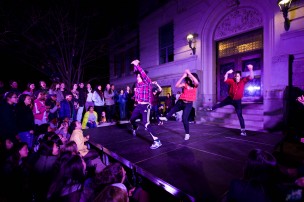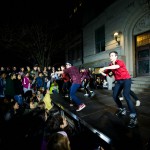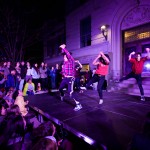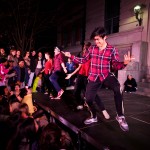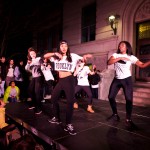On Saturday at 9:30 p.m., a party began on the Allbritton steps that rivaled most of the entire night’s events as FUSION Dance Crew put on a show of explosive talent.
FUSION, as its name suggests, combines a wide variety of influences and types of dance in its performances. The majority of Saturday’s pieces were hip-hop or at least hip-hop-influenced, but, as their Facebook page event details, “voguing, street jazz, breaking, waacking, and krump” were also involved.
The show began with a half-hour party during which members of the group danced freely onstage, occasionally pulling up members of the audience. Then, at 10 p.m., the speakers began blasting “Truffle Butter,” and the entire cast burst onto the stage to signal the beginning of the show.
After a brief announcement from the heads of FUSION, the series of short, consecutive performances began. Each dance ended relatively abruptly and the music would fade, the next song starting within a couple seconds to form one continuously energetic half hour. One standout performance was a solo piece to Drake’s “Jungle” choreographed and danced by Suki Lkhagvadorj ’15.
Musical highlights included Drake’s “Know Yourself,” Chance the Rapper’s “Juice,” and a Meek Mill medley.
The informal leaders of FUSION are Lucas McLaughlin ’15, Liza Sankar-Gorton ’15, and Mika Reyes ’17, but the group is a collaborative effort at its core. The leaders handle details like scheduling in addition to choreographing and dancing with the group. Anyone in the crew can choreograph, which results in a huge variation in style, and most choreographers welcome suggestions from their dancers.
“I honestly didn’t realize how diverse our dancing styles are until we had showings,” said Amira Ottley ’18. “Each person has a different process of creating moves and teaching it to the rest of us.”
For this show, those wanting to choreograph were given two weeks to prepare their pieces before members chose which dances they wanted to join. Sankar-Gorton and McLaughlin made sure dancers were divided up equally and adjusted the groups for choreographers who wanted only one gender in their pieces.
“I love [dancing in] FUSION because it’s a mix of many different dance styles,” said Tyler Clarke ’18. “It’s amazing because when we’re all in a room together someone will put on a song and we all just start dancing in our own spaces.”
This active creative process came through in the performances themselves. As the dancers fed off each other’s energy, they also absorbed energy from the crowd, who cheered for certain moves or chanted along to “Know Yourself.” FUSION’s relationship with their audience is an essential part of their performance: not only did they throw Solo cups and dollar bills into the crowd, but they also invited their cheers, reacting to them physically as if letting the audience’s enthusiasm motivate them to dance more.
Although this free movement drives FUSION’s performances, the show had some more polished elements. Loose costumes pulled the dancers together aesthetically: in one piece, everyone wore sports jerseys; in another, they wore various white T-shirts with black writing.
This polish also emerges in their choreography. Their smooth and seemingly effortless combinations exude confidence and fun, while simultaneously showcasing meticulously planned choreography.
“Before learning it, I honestly never thought I could attempt any of the moves,” Ottley said. “But our group did it!”
The ease and energy with which FUSION’s dancers seem to crank out their moves masks the difficulty of the dances, and I found myself repeatedly forgetting that an incredible amount of skill and technique was involved in each piece.
As the show ended in one enormous dance party, I was struck with the urge to obtain a playlist of what had been danced to, in the hopes of recreating the energy of the performance.
- Lex Spirtes, Photo Editor
- Lex Spirtes, Photo Editor
- Lex Spirtes, Photo Editor
- Lex Spirtes, Photo Editor
